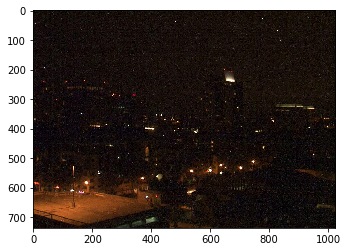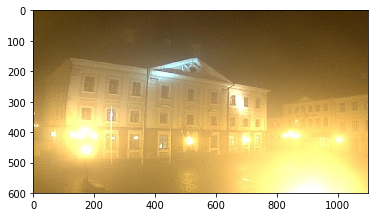Clasificador de imágenes en día o noche
Escrito por
11 minutos de lectura
import numpy as np
import matplotlib.pyplot as plt
import matplotlib.image as mpimg
import os
import cv2
%matplotlib inline
# Image data directories
image_dir_training = "images/training/" # 60%
image_dir_test = "images/test/" # 40%
categories = ["day", "night"]
# Create the datasets' arrays
training_data = []
test_data = []
def appendImagesToArray(images_path):
data_array = training_data if images_path == training_path else test_data
for img in os.listdir(images_path):
try:
img_array = cv2.imread(os.path.join(images_path,img))
img_array = cv2.cvtColor(img_array, cv2.COLOR_BGR2RGB)
data_array.append([img_array, class_name])
except Exception as e:
pass
for category in categories:
training_path = os.path.join(image_dir_training, category)
test_path = os.path.join(image_dir_test, category)
class_name = categories[categories.index(category)]
# Append images to the training_data array
appendImagesToArray(training_path)
# Append images to the test_data array
appendImagesToArray(test_path)
Visualize the input images
# Display a night image
image_index = 0
while training_data[image_index][1] == "day":
image_index += 1
if training_data[image_index][1] == "night":
night_image = training_data[image_index][0]
break
plt.imshow(night_image)
<matplotlib.image.AxesImage at 0x7f4da02258d0>

Pre-process the Data
def standardize_input(image):
""""Resize image to the size 1100x600 (wxh)"""
standard_im = cv2.resize(image, (1100, 600))
return standard_im
def encode(label):
"""Output 1 if label is day and 0 if it's night"""
numerical_val = 1 if label == "day" else 0
return numerical_val
def standardize(image_list):
# Empty image data array
standard_list = []
# Iterate through all the image-label pairs
for item in image_list:
image = item[0]
label = item[1]
# Standardize the image
standardized_im = standardize_input(image)
# Create a numerical label
binary_label = encode(label)
# Append the image, and it's one hot encoded label to the full, processed list of image data
standard_list.append((standardized_im, binary_label))
return standard_list
# Standardize all training images
STANDARDIZED_TRAINING_LIST = standardize(training_data)
STANDARDIZED_TEST_LIST = standardize(test_data)
# Display a standardized image and its label
# Select an image by index
image_num = 0
selected_image = STANDARDIZED_TRAINING_LIST[image_num][0]
selected_label = STANDARDIZED_TRAINING_LIST[image_num][1]
# Display image and data about it
## TODO: Make sure the images have numerical labels and are of the same size
plt.imshow(selected_image)
print("Shape: "+str(selected_image.shape))
print("Label [1 = day, 0 = night]: " + str(selected_label))
Shape: (600, 1100, 3)
Label [1 = day, 0 = night]: 1

Feature Extraction
# Convert and image to HSV colorspace
# Visualize the individual color channels
image_num = 0
test_im = STANDARDIZED_TEST_LIST[image_num][0]
test_label = STANDARDIZED_TEST_LIST[image_num][1]
# Convert to HSV
hsv = cv2.cvtColor(test_im, cv2.COLOR_RGB2HSV)
# Print image label
print('Label: ' + str(test_label))
# HSV channels
h = hsv[:,:,0]
s = hsv[:,:,1]
v = hsv[:,:,2]
# Plot the original image and the three channels
f, (ax1, ax2, ax3, ax4) = plt.subplots(1, 4, figsize=(20,10))
ax1.set_title('Standardized image')
ax1.imshow(test_im)
ax2.set_title('H channel')
ax2.imshow(h, cmap='gray')
ax3.set_title('S channel')
ax3.imshow(s, cmap='gray')
ax4.set_title('V channel')
ax4.imshow(v, cmap='gray')
Label: 1
<matplotlib.image.AxesImage at 0x7f4d69d2a208>

# Find the average Value or brightness of an image
def avg_brightness(rgb_image):
# Convert image to HSV
hsv = cv2.cvtColor(rgb_image, cv2.COLOR_RGB2HSV)
# Add up all the pixel values in the V channel
sum_brightness = np.sum(hsv[:,:,2])
# Calculate the average brightness using the area of the image
# and the sum calculated above
area = 600 * 1100.0
avg = sum_brightness / area
return avg
image_num = 150
test_im = STANDARDIZED_TEST_LIST[image_num][0]
avg = avg_brightness(test_im)
print('Avg brightness: ' + str(avg))
plt.imshow(test_im)
Avg brightness: 176.83844242424243
<matplotlib.image.AxesImage at 0x7f4d6988b2b0>

Classification
# This function should take in RGB image input
def estimate_label(rgb_image):
# TO-DO: Extract average brightness feature from an RGB image
avg_brgt = avg_brightness(rgb_image)
# Use the avg brightness feature to predict a label (0, 1)
predicted_label = 0
# TO-DO: Try out different threshold values to see what works best!
threshold = 100.0
if(avg_brgt > threshold):
# if the average brightness is above the threshold value, we classify it as "day"
predicted_label = 1
# else, the predicted_label can stay 0 (it is predicted to be "night")
return predicted_label
import random
random.shuffle(STANDARDIZED_TEST_LIST)
# Constructs a list of misclassified images given a list of test images and their labels
def get_misclassified_images(test_images):
# Track misclassified images by placing them into a list
misclassified_images_labels = []
# Iterate through all the test images
# Classify each image and compare to the true label
for image in test_images:
# Get true data
im, true_label = image[0], image[1]
# Get predicted label from your classifier
predicted_label = estimate_label(im)
# Compare true and predicted labels
if(predicted_label != true_label):
# If these labels are not equal, the image has been misclassified
misclassified_images_labels.append((im, predicted_label, true_label))
# Return the list of misclassified [image, predicted_label, true_label] values
return misclassified_images_labels
# Find all misclassified images in a given test set
MISCLASSIFIED = get_misclassified_images(STANDARDIZED_TEST_LIST)
# Accuracy calculations
total = len(STANDARDIZED_TEST_LIST)
num_correct = total - len(MISCLASSIFIED)
accuracy = num_correct/total
print('Accuracy: ' + str(accuracy))
print("Number of misclassified images = " + str(len(MISCLASSIFIED)) +' out of '+ str(total))
Accuracy: 0.925
Number of misclassified images = 12 out of 160
# Visualize example
num = 0
test_mis_im = STANDARDIZED_TEST_LIST[num][0]
plt.imshow(test_mis_im)
print(STANDARDIZED_TEST_LIST[num][1]) # day = 1, night = 0
1

¿Quieres contactar conmigo?
Reporta un bug
Para cualquier error en la web o en la escritura, porfavor abre un issue en Github.
GithubMándame un mensaje
Siéntete libre de mandarme un tweet con cualquier recomendación o pregunta.
Twitter